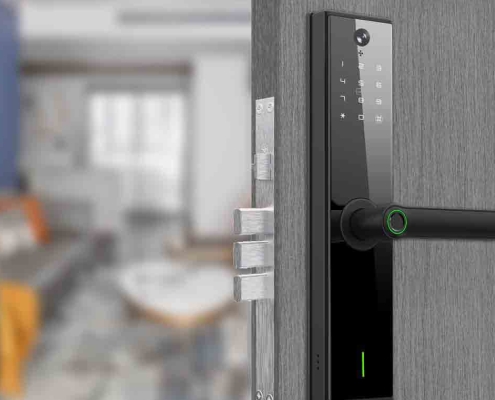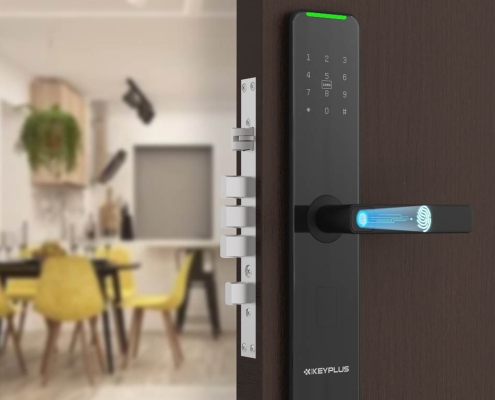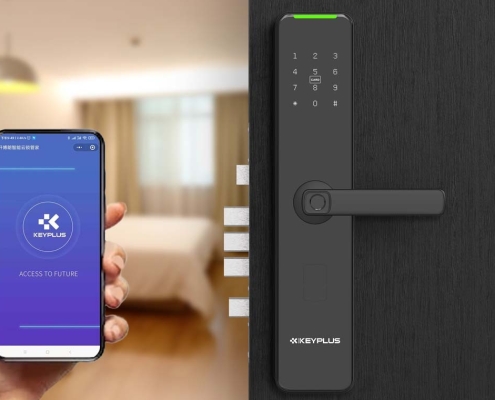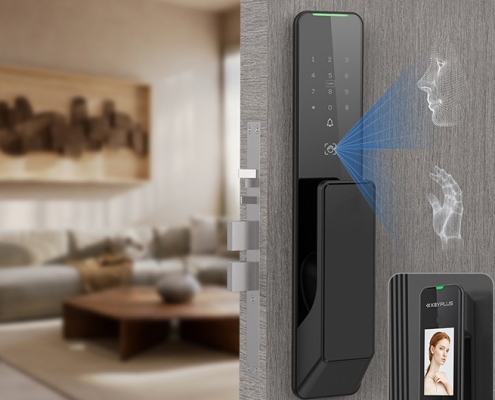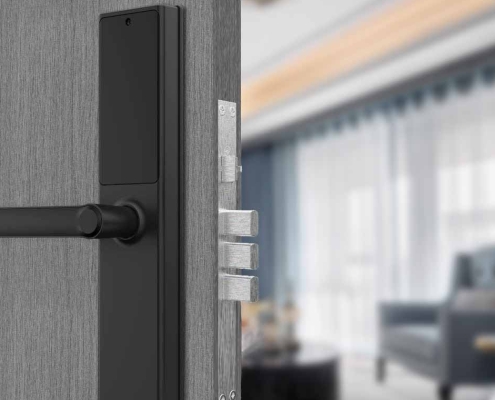Hotel lock:How do RFID door locks work?
That smooth, effortless tap of your key card against the hotel room door – a simple action marking the start of your stay. Gone are the days of fiddling with metal keys or clumsily swiping magnetic stripes. Today, Radio-Frequency Identification (RFID) technology silently powers this seamless entry, enhancing both convenience and security. But how do these modern marvels actually work? Let’s demystify the process, step by step.
The Core Idea: Wireless Communication
At its heart, an RFID hotel lock system is about wireless communication. It involves three key players working together:
-
The RFID Key Card/Tag: This is the device you carry – typically a plastic card, but sometimes a key fob or even integrated into a wristband. Crucially, it contains a tiny, passive RFID chip and antenna. “Passive” means it has no internal battery. It only springs to life when powered by an external signal.
-
The RFID Reader (in the Door Lock): Embedded within the door lock mechanism, usually behind the faceplate near where you tap, is the reader module. This contains its own antenna and a small computer. Its job is to generate a radio frequency (RF) field and listen for responses from nearby RFID tags.
-
The Central Management System (Backend Server): This is the brain of the operation, usually located at the hotel’s front desk or server room. It controls which keys are valid for which rooms and during which times.
The Unlocking Dance: Step-by-Step
Here’s what happens when you present your key to the lock:
-
Powering Up the Tag: When you bring your RFID key card close to the lock (typically within 1-2 inches), the reader’s antenna emits a low-power, specific radio frequency signal (often 13.56 MHz, part of the HF – High Frequency – standard).
-
Tag Awakens and Responds: The antenna within your key card captures energy from this radio wave. This harvested energy is just enough to briefly power the tiny chip embedded in the card. The chip then uses this power to transmit its unique identification number (UID) back to the reader via the card’s antenna. This entire power-and-response cycle happens in milliseconds.
-
Reader Checks the Credentials: The lock’s reader receives the UID from your key card. However, this UID alone isn’t enough to open the door. Think of it like someone shouting their name outside a secure building – you need to verify they are actually allowed in.
-
The Lock Makes a Decision (Offline): Here’s where the system’s intelligence shines. Modern RFID hotel locks are primarily “offline” systems. This means the lock itself contains a significant amount of decision-making power, stored in its local memory. When the lock was last programmed (usually via a master key or connected to the network during maintenance), it downloaded a list of authorized key UIDs and their specific permissions (e.g., valid room number, check-out date/time, access level like guest or housekeeping) from the Central Management System.
-
Validation Happens Locally: The lock’s internal processor compares the UID it just received from your key card against its stored list of authorized credentials. It checks:
-
Is this UID on the valid list for this specific room?
-
Is the key currently within its valid time window (i.e., not expired, not checked out yet)?
-
Does the key have the correct access level (e.g., guest vs. staff master)?
-
-
The Grand Finale: Open or Denied:
-
If Valid: The processor sends a signal to the lock’s solenoid – a small electromagnetic component. The solenoid retracts the bolt or latch mechanism inside the door, allowing you to turn the handle and enter. You’ll usually see a green LED light and/or hear a click.
-
If Invalid: The lock remains securely bolted. You’ll typically see a red LED light. The lock may also log the failed attempt.
-
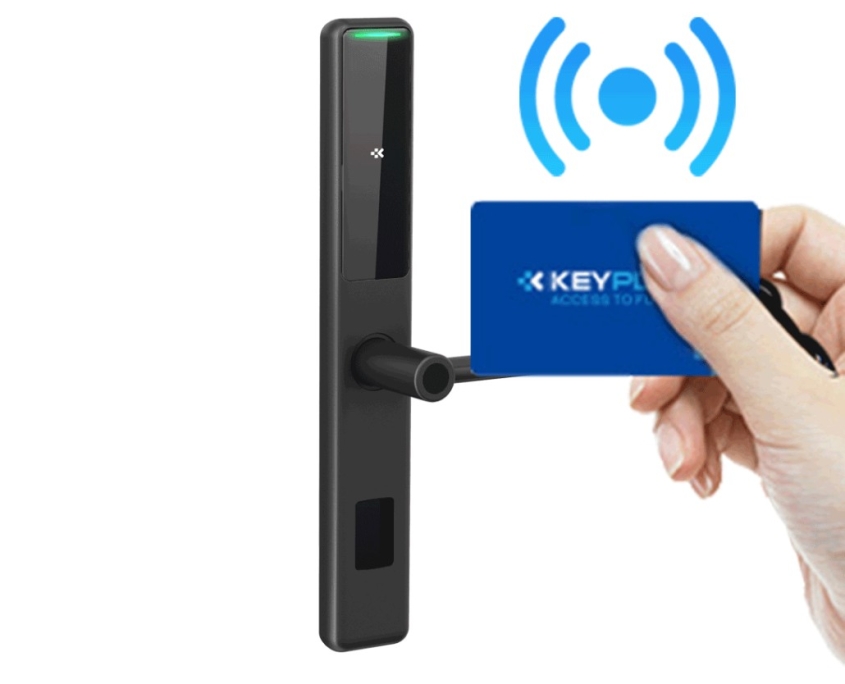
Why RFID Beats the Old Ways (Magstripe)
Hotels widely adopted RFID for compelling reasons beyond just the cool factor:
-
Enhanced Durability & Reliability: No swiping! RFID cards aren’t susceptible to wear and tear from physical contact like magnetic stripes, which can demagnetize from phones, other cards, or simply fray. They are also less prone to damage from bending. The contactless nature means less mechanical wear on the lock reader itself.
-
Faster & More Convenient: A simple tap is significantly quicker and easier than precisely aligning and swiping a magstripe card, especially with luggage in hand. It just works.
-
Improved Security:
-
Harder to Copy: Copying a magstripe card is relatively simple with common devices. Copying an RFID credential requires specialized equipment and knowledge. While not impossible, it’s a higher barrier.
-
Encrypted Data: Modern RFID systems use encryption. The data exchanged between the card and lock isn’t just the raw UID flying through the air. Sophisticated cryptographic protocols (like AES) are used. The lock and card perform a secure “handshake,” exchanging encrypted codes that prove the card is genuine and authorized, without revealing the actual secret keys easily. This thwarts common attacks like “eavesdropping” on the radio signal.
-
Dynamic Codes (Advanced Systems): Some high-security systems use rolling codes or challenge-response protocols, where the data transmitted changes with each use, making captured data useless for replay attacks.
-
Granular Control: Keys can be programmed with exact check-in/check-out times and specific access levels instantly from the front desk. Deactivating a lost key is immediate via the central system, which pushes an update to the specific lock(s) the next time they are online or via a master key.
-
-
Larger Data Capacity: RFID chips can hold more information than a magstripe, allowing for features like integrating with in-room safes, loyalty programs, or energy management systems (turning on AC when the door unlocks).
Security Considerations: It’s Not Magic Armor
While significantly more secure than magstripe, RFID isn’t infallible. Potential concerns exist, though reputable hotel systems implement strong mitigations:
-
Theoretical Eavesdropping/Skimming: A sophisticated attacker could potentially intercept the radio communication between card and reader with specialized equipment held very close by. Mitigation: Encryption (AES) makes the intercepted data gibberish without the secret keys. Short read range (requiring proximity) also limits this threat.
-
Relay Attacks: A more complex attack involving two devices: one near the victim’s card (e.g., in a crowded lobby) and one near the target lock, relaying the signal over a greater distance. Mitigation: Systems using encryption and challenge-response protocols are highly resistant. Time-sensitive codes also help. Physical security (staff vigilance) is key.
-
Physical Tampering: Like any lock, the door hardware itself could be vulnerable to forced entry. RFID doesn’t change this fundamental aspect of physical security.
Beyond the Card: The Future is in Your Hand
RFID paved the way, but the technology is evolving. Increasingly, hotels are leveraging:
-
Mobile Key Technology: Using your smartphone (via Bluetooth Low Energy – BLE or Near Field Communication – NFC) as the “key.” The principle is similar: your phone’s secure element stores a digital credential. When you approach the door, the lock and phone communicate wirelessly. The phone provides proof of authorization (encrypted, of course), and the lock opens if valid. This offers ultimate convenience (no card to lose) and can integrate seamlessly with hotel apps for check-in and other services.
-
Biometric Integration: Some high-end systems are starting to incorporate fingerprint or facial recognition, often alongside RFID or mobile keys for added security layers or specific access scenarios.
The Takeaway: Seamless Security
RFID hotel door locks represent a significant leap in balancing convenience and security for travelers. By harnessing the power of short-range wireless communication, local intelligence within the lock, strong encryption, and centralized management, they provide a fast, reliable, and robust way to control access. That simple tap on your door isn’t just convenient; it’s the result of sophisticated engineering working tirelessly behind the scenes to make your stay smooth and secure. The next time you effortlessly enter your room, you’ll appreciate the invisible, yet powerful, technology granting you access to your home away from home.


